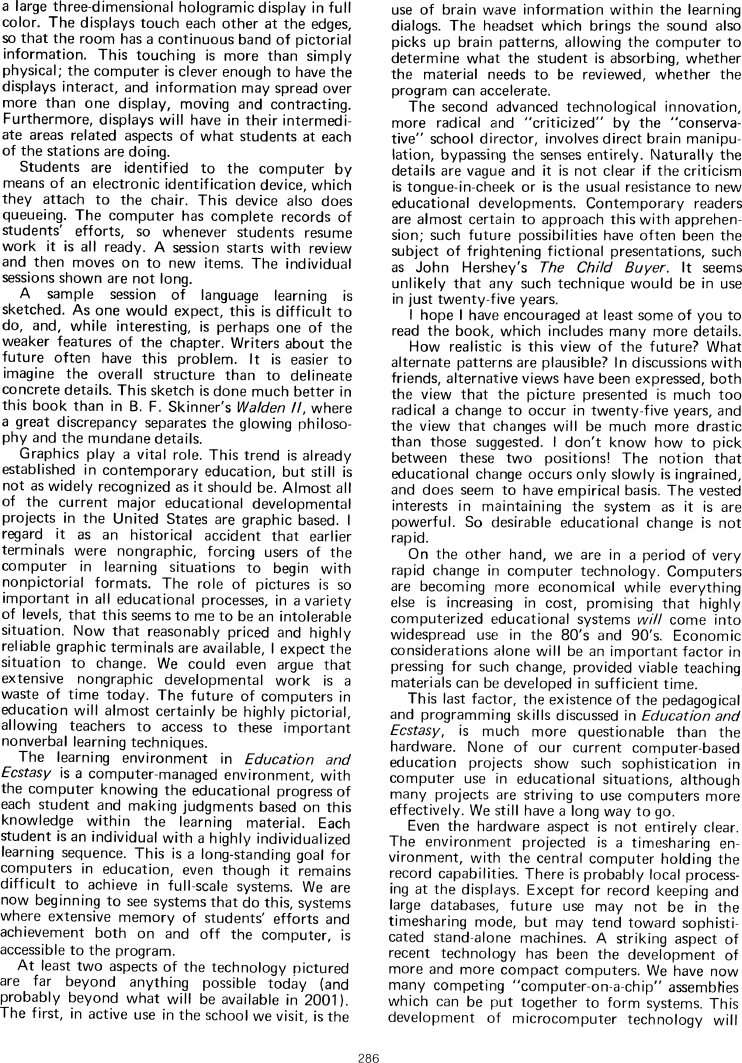The Best of Creative Computing Volume 1 (published 1976)
Education and Ecstasy

a large three-dimensional hologramic display in full color. The displays touch
each other at the edges, so that the room has a continuous band of pictorial
information. This touching is more than simply physical; the computer is clever
enough to have the displays interact, and information may spread over more than
one display, moving and contracting. Furthermore, displays will have in their
intermediate areas related aspects of what students at each of the stations are
doing.
Students are identified to the computer by means of an electronic identification
device, which they attach to the chair. This device also does queueing. The
computer has complete records of students' efforts, so whenever students resume
work it is all ready. A session starts with review and then moves on to new
items. The individual sessions shown are not long.
A sample session of language learning is sketched. As one would expect, this is
difficult to do, and, while interesting, is perhaps one of the weaker features
of the chapter. Writers about the future often have this Problem. lt is easier
to imagine the overall structure than to delineate concrete details. This sketch
is done much better in this book than in B. F. Skinner's Walden //, where a
great discrepancy separates the glowing philosophy and the mundane details.
Graphics play a vital role. This trend is already established in contemporary
education, but still is not as widely recognized as it should be. Almost all of
the current major educational developmental projects in the United States are
graphic based. I regard it as an historical accident that earlier terminals were
nongraphic, forcing users of the computer in learning situations to begin with
nonpictorial formats. The role of pictures is so important in all educational
processes, in a variety of levels, that this seems to me to be an intolerable
situation. Now that reasonably priced and highly reliable graphic terminals are
available, l expect the situation to change. We could even argue that extensive
nongraphic developmental work is a waste of time today. The future of computers
in education will almost certainly be highly pictorial, allowing teachers to
access to these important nonverbal learning techniques.
The learning environment in Education and Ecstasy is a computer-managed
environment, with the computer knowing the educational progress of each student
and making judgments based on this knowledge within the learning material. Each
student is an individual with a highly individualized learning sequence. This is
a long standing goal for computers in education, even though it remains
difficult to achieve in full-scale systems. We are now beginning to see systems
that do this, systems where extensive memory of students' efforts and
achievement both on and off the Computer, is accessible to the program.
At least two aspects of the technology pictured are far beyond anything possible
today (and probably beyond what will be available in 2001). The first, in active
use in the school we visit, is the use of brain wave information within the
learning dialogs. The headset which brings the sound also picks up brain
patterns, allowing the computer to determine what the student is absorbing,
whether the material needs to be reviewed, whether the program can accelerate.
The second advanced technological innovation, more radical and "criticized" by
the "conservative" school director, involves direct brain manipulation,
bypassing the senses entirely. Naturally the details are vague and it is not
clear if the criticism is tongue-in-cheek or is the usual resistance to new
educational developments. Contemporary readers are almost certain to approach
this with apprehension; such future possibilities have often been the subject of
frightening fictional presentations, such as John Hershey's The Child Buyer. It
seems unlikely that any such technique would be in use in just twenty-five
Years.
l hope l have encouraged at least some of you to read the book, which includes
many more details. How realistic is this view of the future? What alternate
patterns are plausible? In discussions with friends, alternative views have been
expressed, both the view that the picture presented is much too radical a change
to occur in twenty-five years, and the view that changes will be much more
drastic than those suggested. I don't know how to pick between these two
positions! The notion that educational change occurs only slowly is ingrained,
and does seem to have empirical basis. The vested interests in maintaining the
system as it is are powerful. So desirable educational change is not rapid.
On the other hand, we are in a period of very rapid change in computer
technology. Computers are becoming more economical while everything else is
increasing in cost, promising that highly computerized educational systems will
come into widespread use in the 80's and 90's. Economic considerations alone
will be an important factor in pressing for such change, provided viable
teaching materials can be developed in sufficient time.
This last factor, the existence of the pedagogical and programming skills
discussed in Education and Ecstasy, is much more questionable than the hardware.
None of our current computer-based education projects show such sophistication
in computer use in educational situations, although many projects are striving
to use computers more effectively. We still have a long way to go.
Even the hardware aspect is not entirely clear. The environment projected is a
timesharing environment, with the central computer holding the record
capabilities. There is probably local processing at the displays. Except for
record keeping and large databases, future use may not be in the timesharing
mode, but may tend toward sophisticated stand-alone machines. A striking aspect
of recent technology has been the development of more and more compact
computers. We have now many competing "computer-on-a-chip" assemblies which can
be put together to form systems. This development of microcomputer technology
will


